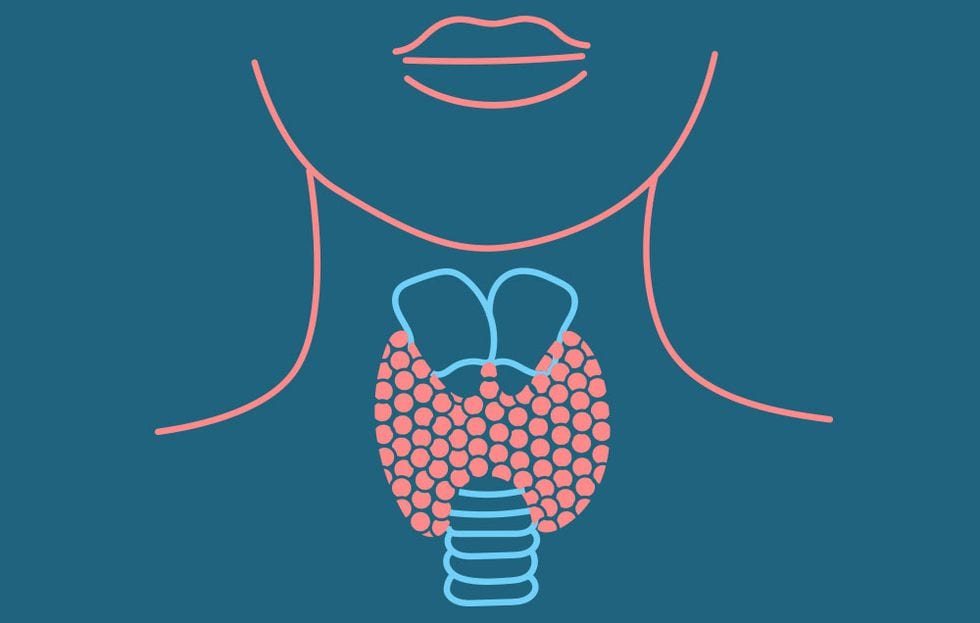This small but mighty, shield shaped gland is located in the front of the neck and plays an enormous role in our overall health. Every cell in the body, except red blood cells, has a receptor site for thyroid hormones, and these regulate temperature and metabolism. The thyroid influences almost every bodily function, so when it is not working properly you can experience a wide range of signs and symptoms.
Under-active or Overactive?
You might hear the terms under-active and overactive thrown around from time to time when it comes to talking about the thyroid.
Under-active Thyroid
Hypo or low thyroid function means the thyroid gland is under-active and it does not product enough thyroid hormone. High cortisol (stress hormones) can cause the thyroid to stop producing thyroid hormones and this is known as hypothyroidism.
Environmental stress can also be a cause of an under-active thyroid, and this is highly linked to individual genetic predispositions.
The major signs and symptoms of under-active thyroid issues are fatigue, hair loss, weight gain, foggy brain , depression, brittle nails, shortness of breathe, anxiety, irregular periods, sensitivity to the cold, bowel problems and a general feeling of un-wellness.
Over-active Thyroid
Hyper or high thyroid functions means the thyroid gland is overactive, and producing far too many thyroid hormones. Again internal and external environment stress can cause the hypothalamus and pituitary glands to send the wrong message to the thyroid gland, causing it to over produce.
The signs and symptoms are fairly similar to those of an under-active thyroid, but weight loss is more prevalent, along with a very rapid heart rate, heart palpitations, anxiety, unable to control temperature and shakiness throughout the body.
Hyperthyroidism is far more dangerous that hypo and needs to be addressed quickly due to the heart’s involvement with hyperthyroidism or Grave’s Disease as it is known.
Graves’ Disease and Hashimoto’s
Graves’ Disease and Hashimoto’s are the names given to thyroid disease if the immune system is involved; this means that the problem is autoimmune.
Besides medications, controlling environmental factors in both Hashimoto’s and Graves’ is paramount. Reducing stress and eating a whole food, plant-based fat free diet makes a monumental difference to both diseases.
Lifestyle factors to support thyroid health
Staying gluten free is one of the most important things if diagnosed with a thyroid issue. The gluten protein is extremely similar to the protein structure found within the thyroid. This similarity is called cellular mimickery and causes the immune system to see the thyroid as similar to gluten. If you have a sensitivity to gluten, it will want to destroy the gland, this is the first step to autoimmune thyroid disease.
A low ‘free-fat’ diet is also one of the keys to supporting thyroid problems. The thyroid itself only produces 7% of the active hormone T3 (what the cell can use) and the other 93% , known as T4, must travel via transporter proteins to the liver and gut for conversion to active T3. These transporter proteins have a strong affinity to fat, so if the diet is full of ‘free’ fats (those that come from a bottle or a jar) bind to these transporters not allowing them to pick up the inactive T4 for transportation to the liver.
How Flourish can help with the natural anti-inflammatory and beetroot powder
All three of our blends have a role to play when it comes to supporting thyroid health.
If the liver is filled with fat also from a high-fat diet, then it is unable to make the conversion. Our detox blend has been designed to aid this very function of the liver.
Good gut bacteria is also responsible for converting 20% of the inactive T4 to active T3, so our prebiotic, gut blend should also be front of mind if you have a thyroid issue.
If the gut is inflamed the bacteria all go to sleep for want of a better description, so are unable to perform the conversion properly. Decreasing inflammation not only in the gut, but also all through the body should be top of mind as well. And that’s where our Turmeric blend comes in.
Find out more about our blends here.
You might also be interested in “Let’s talk about inflammation“.


